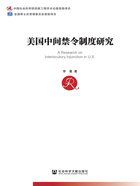
Abstract
Chapter Ⅰ Introduction is about the basic structure of this book. The interlocutory injunction is one of the interim remedies in U.S. that provides the model of discretion. As an equity remedy,a specific remedy and an interlocutory remedy,interlocutory injunction has a different design no matter on discretion or the due process. Equity provides discretion and principle-oriented model. Temporality provides low standard of proof and flexible due process. The remedy hierarchy in U.S. is the evidence of the above. The flexibility in common law system is more than that is in civil law system. The interlocutory injunction in U.S. is a good choice if the flexibility is pursued.
Chapter Ⅱ puts analysis on the common elements of the standard. There are four classic elements that are possibility of success on the merits,irreparable injury,balance of hardship and public interest. The irreparable harm is the core of the standard. The classic and current theories consider rights as the object,the harm that can not be repaired with substitutive remedies and final specific remedies. There are two approaches that are balancing approach and elements approach. There are four elements required in these two. Compared with this,there are two-part test and three-part test which only two or three elements are required. Besides these,there is a sliding scale method that needs to balance more than four elements.
Chapter Ⅲ abstracts the basic theory of due process from interlocutory injunction perspective. It can be seen that due process has its characteristics in interlocutory injunction. The theory of due process in this context is guided by the function of the specific procedure. The basic elements of due process shall be needed to gurantee that parties know the information and can express their opinions.
Chapter Ⅳ shall be on the specific procedural steps of interlocutory injunction. These steps in the whole process are to gurantee the function of the interlocutory injunction. They are flexible initiation,necessary notice and hearing,widened proof,consolidating the hearing with the trial on the merits,consultable order,convertible duration,unconventional appeal,and deterrent enforcement. Security is to protect the respondent from irreparable harm,which is crucial important. It’s necessary to pay attention on the necessity,the scope,the standard and the amount of security from irreparable perspective.
Chapter Ⅴ abstracts the methodology and makes an experience on the conduct preservation in China. First of all,the insufficiency of discretion and due process is the reason why conduct preservation is not functioning properly. To be specific,the problems are the absence of due process elements,the inadequacy of rules and the inexactness of security function. As the standard part,it is a better choice to increase the elements of standard and absorb the method of evaluating irreparable harm. Meanwhile,a clear model that could be named “stable element—flexible balancing” comes into the process of building up the standard of conduct preservation system. As the procedural part,the suggestion on notice and hearing,launching,consolidating of hearing and trial,order-formulating and enforcement will be announced. There is a possibility that security in conduct preservation can be improved detailedly in steps such as the mandatory requirement of security,the scope of movant’s liability,the amount of security,the standard of security and the security of respondent as long as the function of conduction preservation is right and clear.
Keywords:Interlocutory Injunction;Conduct Preservation;Discretion;Irreparable Harm;Due Process